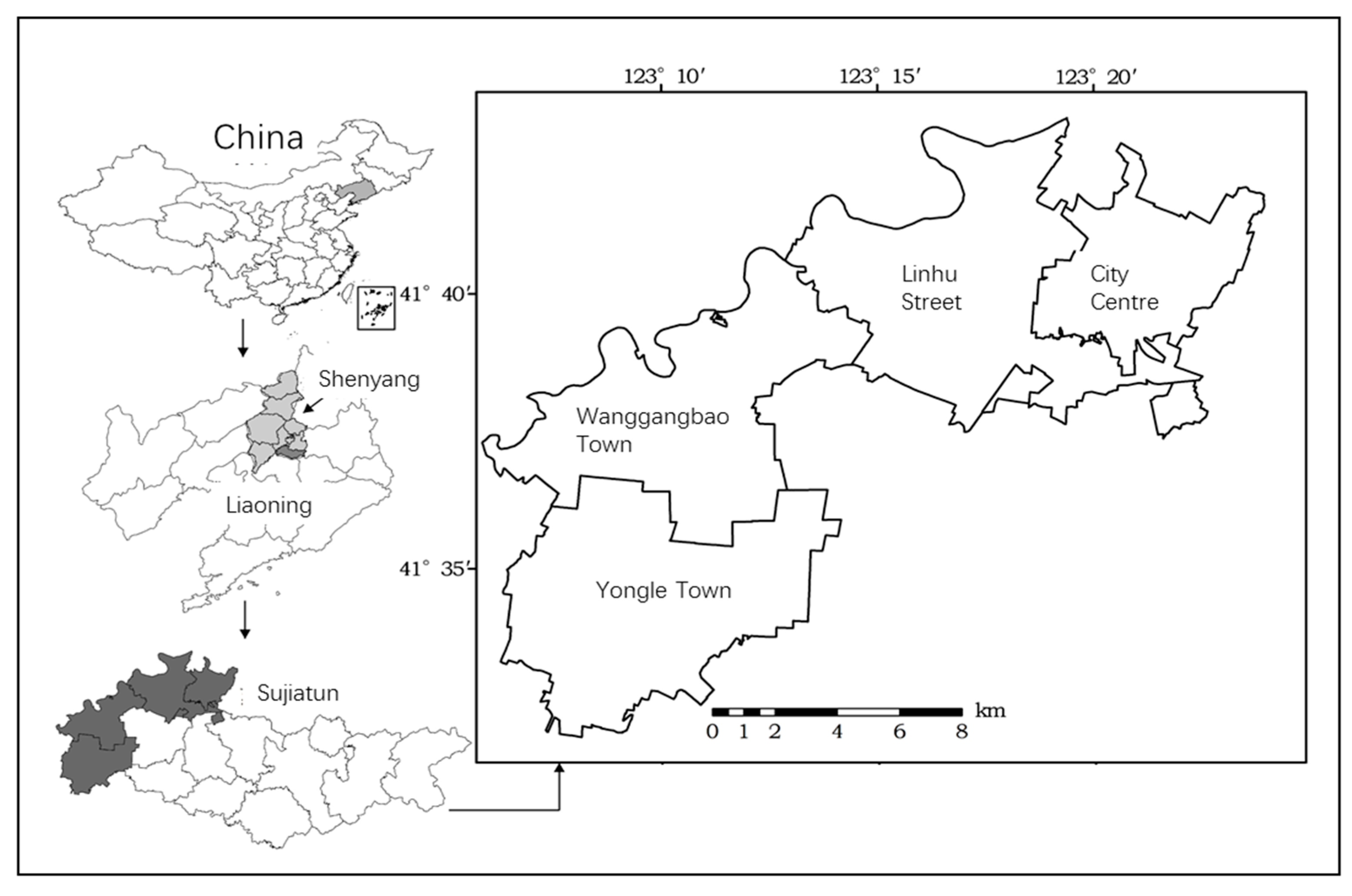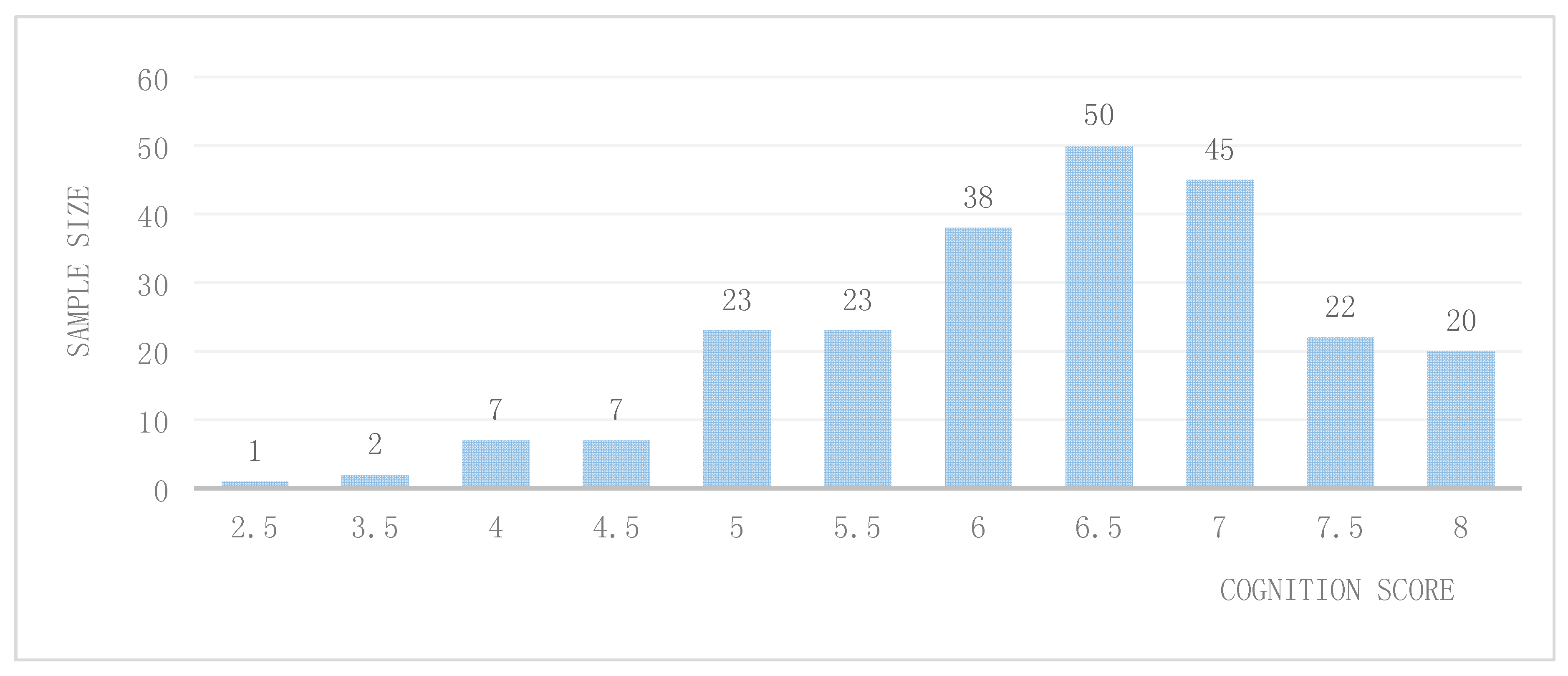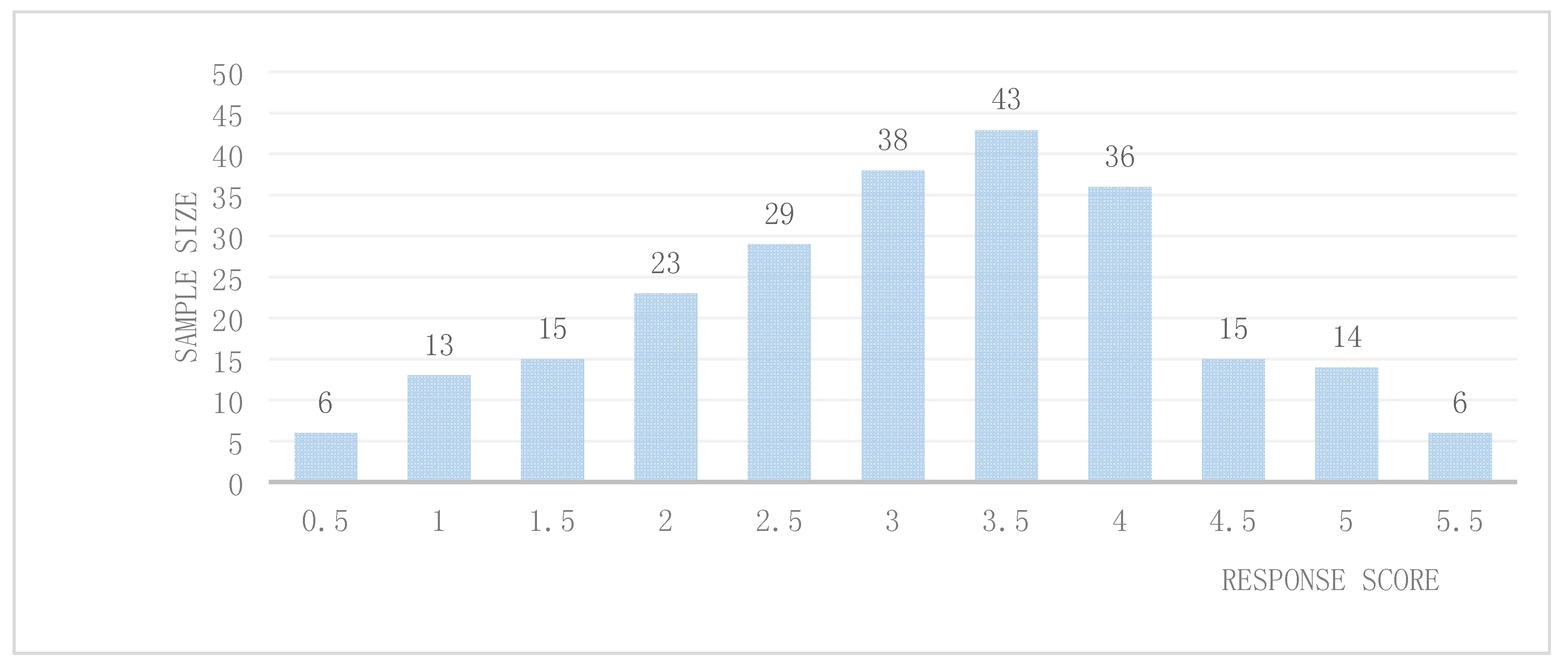Farmers’ Cognition and Behavioral Response towards Cultivated Land Quality Protection in Northeast China
Abstract
1. Introduction
2. Conceptual Framework
3. Materials and Methods
3.1. Study Sites and Samples
3.2. Model Specification and Evaluation Criteria
- -
- CPJ: Two indicators are used to represent CPJ: (i) farmer’s standard to judge land quality (1—thick soil layer without hardening, 0.5—high output, or 0—unknown); and (ii) whether farmers keep an eye on land quality change (1—yes, 0.5—do not care, 0—no).
- -
- CCW: Four indicators are used to stand for CCW: (i) whether farmers regard cultivated land quality protection as important (1—very important, 0.5—important but cannot be overemphasized, 0—not important); (ii) whether farmers are willing to protect cultivated land quality (1—yes, 0—no); (iii) perception on prospect of cultivated land quality protection (1—optimistic, 0.5—medium, 0—pessimistic); and (iv) who are the main responsibility person in cultivated land quality protection (1—farm households, 0—the central and local governments).
- -
- CCP: Two indicators are used to represent CCP: (i) farmers’ cognition on the methods that may improve land quality (1—use manure, 0.5—use household excrement, 0.5—crop rotation, 0—unknown); and (ii) farmers’ cognition of the function of fertilizers (1—moderate fertilization could improve land quality, 0.5—excessive fertilization is a waste, 0—the increase of output entirely depends on the application of fertilizers).
- -
- CLM: The indicator representing CLM is whether farmers would consider crop rotation on the same plot (1—yes, 0—no).
- -
- LIM: Three indicators are used to stand for LIM: (i) use of manure and fertilizers (1—only manure, 0.5—both manure and fertilizers, 0—only fertilizers); (ii) the decision on how much manure and fertilizers to be used is based on…? (1—soil fertility, 0.5—crop variety, 0.5—output in previous year, 0—personal experience); (iii) the use of pesticides is based on…? (1—status of pests and diseases, 0.5—crop variety, 0—personal experience).
- -
- AWTM: Two indicators are used to represent AWTM: (i) disposal of plastic film residue (1—recycling of the large piece of residue, 0.5—only small pieces of residue have been collected and disposed, 0—all plastic film residue has been left in the soil); and (ii) disposal of crop stalks (1—return to field, 0.5—used as fuel, 0.5—discarded, 0—burned in the field).
4. Results and Discussion
4.1. Farmers’ Cognition on CLQP
4.2. Farmers’ Behavioral Response on CLQP
4.3. Consistency between Cognition and Behavioral Response: A Preliminary Test
4.4. Empirical Results
5. Conclusions and Policy Implication
Author Contributions
Acknowledgments
Conflicts of Interest
References
- National Bureau of Statistics of China. Statistical Yearbook of China; China Statistical Publisher House: Beijing, China, 2017. [Google Scholar]
- Deng, X.; Huang, J.; Rozelle, S.; Zhang, J.; Li, Z. Impact of urbanization on cultivated land changes in China. Land Use Policy 2015, 45, 1–7. [Google Scholar] [CrossRef]
- Wu, Y.; Zhang, X.; Skitmore, M.; Song, Y.; Hui, E.C.M. Industrial land price and its impact on urban growth: A Chinese case study. Land Use Policy 2014, 36, 199–209. [Google Scholar] [CrossRef]
- Liang, C.; Jiang, P.; Wei, C.; Li, M.; Wang, L.; Yuan, G.; Yuzhe, P.; Nan, X.; Duan, Y.; Huang, Q. Farmland protection policies and rapid urbanization in China: A case study for Changzhou City. Land Use Policy 2015, 48, 552–566. [Google Scholar] [CrossRef]
- Liu, X.; Zhao, C.; Song, W. Review of the evolution of cultivated land protection policies in the period following China’s reform and liberalization. Land Use Policy 2017, 67, 660–669. [Google Scholar] [CrossRef]
- Lichtenberg, E.; Ding, C. Chapter 5: Assessing Farmland Protection Policy in China. Land Use Policy 2008, 25, 59–68. [Google Scholar] [CrossRef]
- Luo, X.; Zhang, L.; Zhu, Y. Food Security based on Cultivated Land Pressure Index. Chin. Rural Econ. 2016, 2, 83–96. (In Chinese) [Google Scholar]
- Chen, J.; Yu, Z.; Ouyang, J.; Mensvoort, M.E.F.V. Factors affecting soil quality changes in the North China Plain: A case study of Quzhou County. Agric. Syst. 2006, 91, 171–188. [Google Scholar] [CrossRef]
- Yazdanpanah, M.; Feyzabad, F.R.; Forouzani, M.; Mohammadzadeh, S.; Burton, R.J.F. Predicting farmers’ water conservation goals and behavior in Iran: A test of social cognitive theory. Land Use Policy 2015, 47, 401–407. [Google Scholar] [CrossRef]
- Sklenicka, P. Classification of farmland ownership fragmentation as a cause of land degradation: A review on typology, consequences, and remedies. Land Use Policy 2016, 57, 694–701. [Google Scholar] [CrossRef]
- Chang, H.H.; Mishra, A.K.; Livingston, M. Agricultural policy and its impact on fuel usage: Empirical evidence from farm household analysis. Appl. Energy 2011, 88, 348–353. [Google Scholar] [CrossRef]
- Saenz, M.; Thompson, E. Gender and Policy Roles in Farm Household Diversification in Zambia. World Dev. 2017, 89, 152–169. [Google Scholar] [CrossRef]
- Zhang, W.; Wang, W.; Li, X.; Ye, F. Economic development and farmland protection: An assessment of rewarded land conversion quotas trading in Zhejiang, China. Land Use Policy 2014, 38, 467–476. [Google Scholar] [CrossRef]
- Celio, E.; Flint, C.G.; Schoch, P.; Grêt-Regamey, A. Farmers’ perception of their decision-making in relation to policy schemes: A comparison of case studies from Switzerland and the United States. Land Use Policy 2014, 41, 163–171. [Google Scholar] [CrossRef]
- Bijani, M.; Ghazani, E.; Valizadeh, N.; Haghighi, N.F. Pro-environmental analysis of farmers’ concerns and behaviors towards soil conservation in central district of Sari County, Iran. Int. Soil Water Conserv. Res. 2017, 5, 43–49. [Google Scholar] [CrossRef]
- Wang, C.; Gu, H. Farmers’ perception of enviroment, behavior decision and the check of consistency between them: An empirical analysis based on the survey of farmers in Jiangsu province. Resour. Environ. Yangtze Basin 2012, 21, 1204–1208. (In Chinese) [Google Scholar]
- Deng, Z.; Zhang, J.; Xu, Z. Study on households’ cognition and behavior in the improvement of rural environment. Agric. Technol. Econ. 2013, 2, 72–79. (In Chinese) [Google Scholar]
- Ye, Q.; Wang, C. Cognition and its impact factors on the scale effects of village agglomeration based on the structural equation model: Taking Chongqing as Example. China Land Sci. 2015, 29, 82–89. (In Chinese) [Google Scholar]
- Kollmuss, A.; Agyeman, J. Mind the Gap: Why do people act environmentally and what are the barriers to pro-environmental behavior? Environ. Educ. Res. 2002, 8, 239–260. [Google Scholar] [CrossRef]





| Cognition | Indicator | Options | Score | Sample Size | Proportion (%) |
|---|---|---|---|---|---|
| Farmer’s cognition and judgement on CLQP status (CPJ) | Farmer’s standard for judging land quality | Thick soil layer without hardening | 1 | 109 | 45.80 |
| High output | 0.5 | 103 | 43.28 | ||
| Unknown | 0 | 26 | 10.92 | ||
| Whether farmers keep an eye on land quality change | Yes | 1 | 208 | 87.40 | |
| Do not care | 0.5 | 22 | 9.24 | ||
| No | 0 | 8 | 3.36 | ||
| Farmer’s cognition on CLQP policies (CCW) | Whether farmers regard cultivated land quality protection as important | Very important | 1 | 206 | 85.55 |
| Important but cannot be overemphasized | 0.5 | 23 | 9.67 | ||
| Not important | 0 | 9 | 3.78 | ||
| Whether farmers are willing to protect cultivated land quality | Yes | 1 | 234 | 98.32 | |
| No | 0 | 4 | 1.68 | ||
| Perception on prospect of cultivated land quality protection | Optimistic | 1 | 24 | 10.08 | |
| Medium | 0.5 | 102 | 42.86 | ||
| Pessimistic | 0 | 112 | 47.06 | ||
| Who are the main responsible party in cultivated land quality protection | Farm households | 1 | 156 | 65.55 | |
| The government | 0 | 82 | 34.45 | ||
| Farmer’s cognition on CLQP patterns (CCP) | Farmer cognition on the methods that may improve land quality | Use manure | 1 | 219 | 92.02 |
| Use household excrement | 0.5 | 9 | 3.78 | ||
| crop rotation | 0.5 | 5 | 2.10 | ||
| unknown | 0 | 5 | 2.10 | ||
| Farmer cognition on the function of fertilizers | Moderate fertilization could improve land quality | 1 | 115 | 48.32 | |
| Excessive fertilization is a waste | 0.5 | 66 | 27.73 | ||
| The increase of output entirely depends on the application of fertilizers | 0 | 57 | 23.95 | ||
| Composite cognition score (Cogni) | 8 (full score) | ||||
| Behavioral Response | Indicator | Options | Score | Sample Size | Proportion (%) |
|---|---|---|---|---|---|
| Choice of farming methods (CLM) | Whether farmers would consider crop rotation on the same plot | Yes | 1 | 128 | 53.78 |
| No | 0 | 110 | 46.22 | ||
| Choice of land inputs (LIM) | Use of manure and fertilizers | Manure only | 1 | 6 | 2.52 |
| Both manure and fertilizers | 0.5 | 118 | 49.58 | ||
| Fertilizers only | 0 | 114 | 47.90 | ||
| Decision on how much manure and fertilizers to be used is based on…? | Soil fertility | 1 | 31 | 13.03 | |
| Crop variety | 0.5 | 26 | 10.92 | ||
| Output in previous year | 0.5 | 10 | 4.20 | ||
| Personal experience | 0 | 171 | 71.85 | ||
| Use of pesticides is based on…? | Status of pests and diseases | 1 | 148 | 62.18 | |
| Crop variety | 0.5 | 10 | 4.20 | ||
| Personal experience | 0 | 80 | 33.62 | ||
| Choice of agricultural waste disposal methods (AWTM) | Disposal of plastic film residue | Recycling of the large piece of residue | 1 | 146 | 61.34 |
| Only small pieces of residue have been collected and disposed | 0.5 | 48 | 20.17 | ||
| All plastic film residue has been left in the soil | 0 | 44 | 18.49 | ||
| Disposal of crop stalks | Return to field | 1 | 10 | 4.20 | |
| Used as fuel | 0.5 | 158 | 66.39 | ||
| Discarded | 0.5 | 59 | 24.79 | ||
| Burned in the field | 0 | 11 | 4.62 | ||
| Composite response score (Behai) | 6 (full score) | ||||
| Region | Independent Variables a | Dependent Variables b | |||
|---|---|---|---|---|---|
| CLM | LIM | AWTM | |||
| Total | CPJ | Coef. | 0.067 * | ||
| t-value | 1.992 | ||||
| CCW | Coef. | 0.091 ** | 0.082 * | ||
| t-value | 2.202 | 1.347 | |||
| CCP | Coef. | ||||
| t-value | |||||
| Yongle town | CPJ | Coef. | 0.091 * | 0.156 * | |
| t-value | 1.362 | 1.381 | |||
| CCW | Coef. | 0.073 * | |||
| t-value | 1.896 | ||||
| CCP | Coef. | 0.145 ** | 0.610 *** | ||
| t-value | 1.355 | 3.199 | |||
| Wanggangbao town | CPJ | Coef. | |||
| t-value | |||||
| CCW | Coef. | 0.472 * | 0.142 * | ||
| t-value | 2.586 | 1.502 | |||
| CCP | Coef. | ||||
| t-value | |||||
| Linhu street | CPJ | Coef. | |||
| t-value | |||||
| CCW | Coef. | ||||
| t-value | |||||
| CCP | Coef. | ||||
| t-value | |||||
© 2018 by the authors. Licensee MDPI, Basel, Switzerland. This article is an open access article distributed under the terms and conditions of the Creative Commons Attribution (CC BY) license (http://creativecommons.org/licenses/by/4.0/).
Share and Cite
Liu, H.; Zhou, Y. Farmers’ Cognition and Behavioral Response towards Cultivated Land Quality Protection in Northeast China. Sustainability 2018, 10, 1905. https://doi.org/10.3390/su10061905
Liu H, Zhou Y. Farmers’ Cognition and Behavioral Response towards Cultivated Land Quality Protection in Northeast China. Sustainability. 2018; 10(6):1905. https://doi.org/10.3390/su10061905
Chicago/Turabian StyleLiu, Hongbin, and Yuepeng Zhou. 2018. "Farmers’ Cognition and Behavioral Response towards Cultivated Land Quality Protection in Northeast China" Sustainability 10, no. 6: 1905. https://doi.org/10.3390/su10061905
APA StyleLiu, H., & Zhou, Y. (2018). Farmers’ Cognition and Behavioral Response towards Cultivated Land Quality Protection in Northeast China. Sustainability, 10(6), 1905. https://doi.org/10.3390/su10061905





